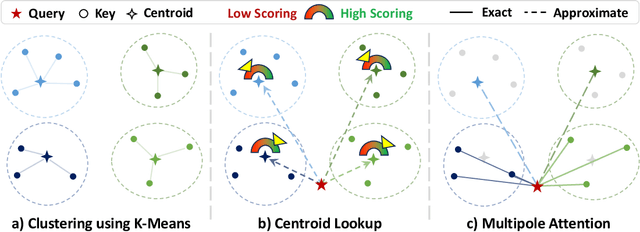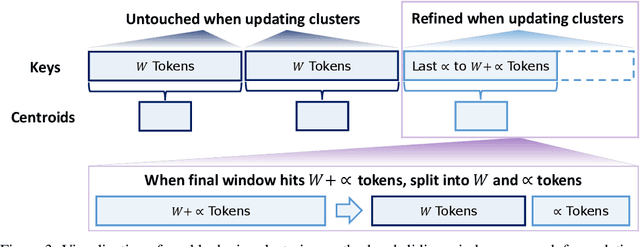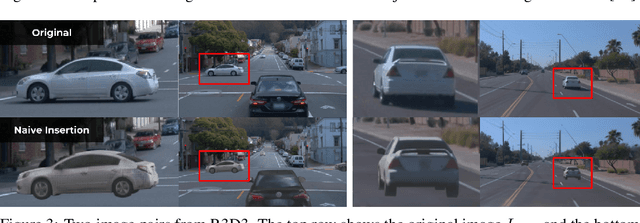Kurt Keutzer
StreamDiffusionV2: A Streaming System for Dynamic and Interactive Video Generation
Nov 10, 2025Abstract:Generative models are reshaping the live-streaming industry by redefining how content is created, styled, and delivered. Previous image-based streaming diffusion models have powered efficient and creative live streaming products but have hit limits on temporal consistency due to the foundation of image-based designs. Recent advances in video diffusion have markedly improved temporal consistency and sampling efficiency for offline generation. However, offline generation systems primarily optimize throughput by batching large workloads. In contrast, live online streaming operates under strict service-level objectives (SLOs): time-to-first-frame must be minimal, and every frame must meet a per-frame deadline with low jitter. Besides, scalable multi-GPU serving for real-time streams remains largely unresolved so far. To address this, we present StreamDiffusionV2, a training-free pipeline for interactive live streaming with video diffusion models. StreamDiffusionV2 integrates an SLO-aware batching scheduler and a block scheduler, together with a sink-token--guided rolling KV cache, a motion-aware noise controller, and other system-level optimizations. Moreover, we introduce a scalable pipeline orchestration that parallelizes the diffusion process across denoising steps and network layers, achieving near-linear FPS scaling without violating latency guarantees. The system scales seamlessly across heterogeneous GPU environments and supports flexible denoising steps (e.g., 1--4), enabling both ultra-low-latency and higher-quality modes. Without TensorRT or quantization, StreamDiffusionV2 renders the first frame within 0.5s and attains 58.28 FPS with a 14B-parameter model and 64.52 FPS with a 1.3B-parameter model on four H100 GPUs, making state-of-the-art generative live streaming practical and accessible--from individual creators to enterprise-scale platforms.
XQuant: Breaking the Memory Wall for LLM Inference with KV Cache Rematerialization
Aug 14, 2025Abstract:Although LLM inference has emerged as a critical workload for many downstream applications, efficiently inferring LLMs is challenging due to the substantial memory footprint and bandwidth requirements. In parallel, compute capabilities have steadily outpaced both memory capacity and bandwidth over the last few decades, a trend that remains evident in modern GPU hardware and exacerbates the challenge of LLM inference. As such, new algorithms are emerging that trade increased computation for reduced memory operations. To that end, we present XQuant, which takes advantage of this trend, enabling an order-of-magnitude reduction in memory consumption through low-bit quantization with substantial accuracy benefits relative to state-of-the-art KV cache quantization methods. We accomplish this by quantizing and caching the layer input activations X, instead of using standard KV caching, and then rematerializing the Keys and Values on-the-fly during inference. This results in an immediate 2$\times$ memory savings compared to KV caching. By applying XQuant, we achieve up to $\sim 7.7\times$ memory savings with $<0.1$ perplexity degradation compared to the FP16 baseline. Furthermore, our approach leverages the fact that X values are similar across layers. Building on this observation, we introduce XQuant-CL, which exploits the cross-layer similarity in the X embeddings for extreme compression. Across different models, XQuant-CL attains up to 10$\times$ memory savings relative to the FP16 baseline with only 0.01 perplexity degradation, and 12.5$\times$ memory savings with only $0.1$ perplexity degradation. XQuant exploits the rapidly increasing compute capabilities of hardware platforms to eliminate the memory bottleneck, while surpassing state-of-the-art KV cache quantization methods and achieving near-FP16 accuracy across a wide range of models.
Radial Attention: $O(n\log n)$ Sparse Attention with Energy Decay for Long Video Generation
Jun 24, 2025Abstract:Recent advances in diffusion models have enabled high-quality video generation, but the additional temporal dimension significantly increases computational costs, making training and inference on long videos prohibitively expensive. In this paper, we identify a phenomenon we term Spatiotemporal Energy Decay in video diffusion models: post-softmax attention scores diminish as spatial and temporal distance between tokens increase, akin to the physical decay of signal or waves over space and time in nature. Motivated by this, we propose Radial Attention, a scalable sparse attention mechanism with $O(n \log n)$ complexity that translates energy decay into exponentially decaying compute density, which is significantly more efficient than standard $O(n^2)$ dense attention and more expressive than linear attention. Specifically, Radial Attention employs a simple, static attention mask where each token attends to spatially nearby tokens, with the attention window size shrinking with temporal distance. Moreover, it allows pre-trained video diffusion models to extend their generation length with efficient LoRA-based fine-tuning. Extensive experiments show that Radial Attention maintains video quality across Wan2.1-14B, HunyuanVideo, and Mochi 1, achieving up to a 1.9$\times$ speedup over the original dense attention. With minimal tuning, it enables video generation up to 4$\times$ longer while reducing training costs by up to 4.4$\times$ compared to direct fine-tuning and accelerating inference by up to 3.7$\times$ compared to dense attention inference.
Multipole Attention for Efficient Long Context Reasoning
Jun 16, 2025



Abstract:Large Reasoning Models (LRMs) have shown promising accuracy improvements on complex problem-solving tasks. While these models have attained high accuracy by leveraging additional computation at test time, they need to generate long chain-of-thought reasoning in order to think before answering, which requires generating thousands of tokens. While sparse attention methods can help reduce the KV cache pressure induced by this long autoregressive reasoning, these methods can introduce errors which disrupt the reasoning process. Additionally, prior methods often pre-process the input to make it easier to identify the important prompt tokens when computing attention during generation, and this pre-processing is challenging to perform online for newly generated reasoning tokens. Our work addresses these challenges by introducing Multipole Attention, which accelerates autoregressive reasoning by only computing exact attention for the most important tokens, while maintaining approximate representations for the remaining tokens. Our method first performs clustering to group together semantically similar key vectors, and then uses the cluster centroids both to identify important key vectors and to approximate the remaining key vectors in order to retain high accuracy. We design a fast cluster update process to quickly re-cluster the input and previously generated tokens, thereby allowing for accelerating attention to the previous output tokens. We evaluate our method using emerging LRMs such as Qwen-8B, demonstrating that our approach can maintain accuracy on complex reasoning tasks even with aggressive attention sparsity settings. We also provide kernel implementations to demonstrate the practical efficiency gains from our method, achieving up to 4.5$\times$ speedup for attention in long-context reasoning applications. Our code is available at https://github.com/SqueezeAILab/MultipoleAttention.
R3D2: Realistic 3D Asset Insertion via Diffusion for Autonomous Driving Simulation
Jun 09, 2025



Abstract:Validating autonomous driving (AD) systems requires diverse and safety-critical testing, making photorealistic virtual environments essential. Traditional simulation platforms, while controllable, are resource-intensive to scale and often suffer from a domain gap with real-world data. In contrast, neural reconstruction methods like 3D Gaussian Splatting (3DGS) offer a scalable solution for creating photorealistic digital twins of real-world driving scenes. However, they struggle with dynamic object manipulation and reusability as their per-scene optimization-based methodology tends to result in incomplete object models with integrated illumination effects. This paper introduces R3D2, a lightweight, one-step diffusion model designed to overcome these limitations and enable realistic insertion of complete 3D assets into existing scenes by generating plausible rendering effects-such as shadows and consistent lighting-in real time. This is achieved by training R3D2 on a novel dataset: 3DGS object assets are generated from in-the-wild AD data using an image-conditioned 3D generative model, and then synthetically placed into neural rendering-based virtual environments, allowing R3D2 to learn realistic integration. Quantitative and qualitative evaluations demonstrate that R3D2 significantly enhances the realism of inserted assets, enabling use-cases like text-to-3D asset insertion and cross-scene/dataset object transfer, allowing for true scalability in AD validation. To promote further research in scalable and realistic AD simulation, we will release our dataset and code, see https://research.zenseact.com/publications/R3D2/.
GeoDrive: 3D Geometry-Informed Driving World Model with Precise Action Control
May 29, 2025Abstract:Recent advancements in world models have revolutionized dynamic environment simulation, allowing systems to foresee future states and assess potential actions. In autonomous driving, these capabilities help vehicles anticipate the behavior of other road users, perform risk-aware planning, accelerate training in simulation, and adapt to novel scenarios, thereby enhancing safety and reliability. Current approaches exhibit deficiencies in maintaining robust 3D geometric consistency or accumulating artifacts during occlusion handling, both critical for reliable safety assessment in autonomous navigation tasks. To address this, we introduce GeoDrive, which explicitly integrates robust 3D geometry conditions into driving world models to enhance spatial understanding and action controllability. Specifically, we first extract a 3D representation from the input frame and then obtain its 2D rendering based on the user-specified ego-car trajectory. To enable dynamic modeling, we propose a dynamic editing module during training to enhance the renderings by editing the positions of the vehicles. Extensive experiments demonstrate that our method significantly outperforms existing models in both action accuracy and 3D spatial awareness, leading to more realistic, adaptable, and reliable scene modeling for safer autonomous driving. Additionally, our model can generalize to novel trajectories and offers interactive scene editing capabilities, such as object editing and object trajectory control.
Sparse VideoGen2: Accelerate Video Generation with Sparse Attention via Semantic-Aware Permutation
May 24, 2025Abstract:Diffusion Transformers (DiTs) are essential for video generation but suffer from significant latency due to the quadratic complexity of attention. By computing only critical tokens, sparse attention reduces computational costs and offers a promising acceleration approach. However, we identify that existing methods fail to approach optimal generation quality under the same computation budget for two reasons: (1) Inaccurate critical token identification: current methods cluster tokens based on position rather than semantics, leading to imprecise aggregated representations. (2) Excessive computation waste: critical tokens are scattered among non-critical ones, leading to wasted computation on GPUs, which are optimized for processing contiguous tokens. In this paper, we propose SVG2, a training-free framework that maximizes identification accuracy and minimizes computation waste, achieving a Pareto frontier trade-off between generation quality and efficiency. The core of SVG2 is semantic-aware permutation, which clusters and reorders tokens based on semantic similarity using k-means. This approach ensures both a precise cluster representation, improving identification accuracy, and a densified layout of critical tokens, enabling efficient computation without padding. Additionally, SVG2 integrates top-p dynamic budget control and customized kernel implementations, achieving up to 2.30x and 1.89x speedup while maintaining a PSNR of up to 30 and 26 on HunyuanVideo and Wan 2.1, respectively.
Improved Immiscible Diffusion: Accelerate Diffusion Training by Reducing Its Miscibility
May 24, 2025Abstract:The substantial training cost of diffusion models hinders their deployment. Immiscible Diffusion recently showed that reducing diffusion trajectory mixing in the noise space via linear assignment accelerates training by simplifying denoising. To extend immiscible diffusion beyond the inefficient linear assignment under high batch sizes and high dimensions, we refine this concept to a broader miscibility reduction at any layer and by any implementation. Specifically, we empirically demonstrate the bijective nature of the denoising process with respect to immiscible diffusion, ensuring its preservation of generative diversity. Moreover, we provide thorough analysis and show step-by-step how immiscibility eases denoising and improves efficiency. Extending beyond linear assignment, we propose a family of implementations including K-nearest neighbor (KNN) noise selection and image scaling to reduce miscibility, achieving up to >4x faster training across diverse models and tasks including unconditional/conditional generation, image editing, and robotics planning. Furthermore, our analysis of immiscibility offers a novel perspective on how optimal transport (OT) enhances diffusion training. By identifying trajectory miscibility as a fundamental bottleneck, we believe this work establishes a potentially new direction for future research into high-efficiency diffusion training. The code is available at https://github.com/yhli123/Immiscible-Diffusion.
Learning Adaptive Parallel Reasoning with Language Models
Apr 21, 2025Abstract:Scaling inference-time computation has substantially improved the reasoning capabilities of language models. However, existing methods have significant limitations: serialized chain-of-thought approaches generate overly long outputs, leading to increased latency and exhausted context windows, while parallel methods such as self-consistency suffer from insufficient coordination, resulting in redundant computations and limited performance gains. To address these shortcomings, we propose Adaptive Parallel Reasoning (APR), a novel reasoning framework that enables language models to orchestrate both serialized and parallel computations end-to-end. APR generalizes existing reasoning methods by enabling adaptive multi-threaded inference using spawn() and join() operations. A key innovation is our end-to-end reinforcement learning strategy, optimizing both parent and child inference threads to enhance task success rate without requiring predefined reasoning structures. Experiments on the Countdown reasoning task demonstrate significant benefits of APR: (1) higher performance within the same context window (83.4% vs. 60.0% at 4k context); (2) superior scalability with increased computation (80.1% vs. 66.6% at 20k total tokens); (3) improved accuracy at equivalent latency (75.2% vs. 57.3% at approximately 5,000ms). APR represents a step towards enabling language models to autonomously optimize their reasoning processes through adaptive allocation of computation.
FGMP: Fine-Grained Mixed-Precision Weight and Activation Quantization for Hardware-Accelerated LLM Inference
Apr 19, 2025Abstract:Quantization is a powerful tool to improve large language model (LLM) inference efficiency by utilizing more energy-efficient low-precision datapaths and reducing memory footprint. However, accurately quantizing LLM weights and activations to low precision is challenging without degrading model accuracy. We propose fine-grained mixed precision (FGMP) quantization, a post-training mixed-precision quantization hardware-software co-design methodology that maintains accuracy while quantizing the majority of weights and activations to reduced precision. Our work makes the following contributions: 1) We develop a policy that uses the perturbation in each value, weighted by the Fisher information, to select which weight and activation blocks to keep in higher precision. This approach preserves accuracy by identifying which weight and activation blocks need to be retained in higher precision to minimize the perturbation in the model loss. 2) We also propose a sensitivity-weighted clipping approach for fine-grained quantization which helps retain accuracy for blocks that are quantized to low precision. 3) We then propose hardware augmentations to leverage the efficiency benefits of FGMP quantization. Our hardware implementation encompasses i) datapath support for FGMP at block granularity, and ii) a mixed-precision activation quantization unit to assign activation blocks to high or low precision on the fly with minimal runtime and energy overhead. Our design, prototyped using NVFP4 (an FP4 format with microscaling) as the low-precision datatype and FP8 as the high-precision datatype, facilitates efficient FGMP quantization, attaining <1% perplexity degradation on Wikitext-103 for the Llama-2-7B model relative to an all-FP8 baseline design while consuming 14% less energy during inference and requiring 30% less weight memory.
 Add to Chrome
Add to Chrome Add to Firefox
Add to Firefox Add to Edge
Add to Edge